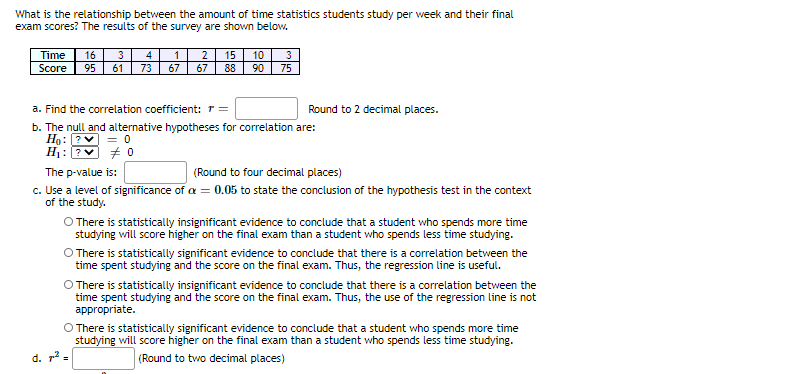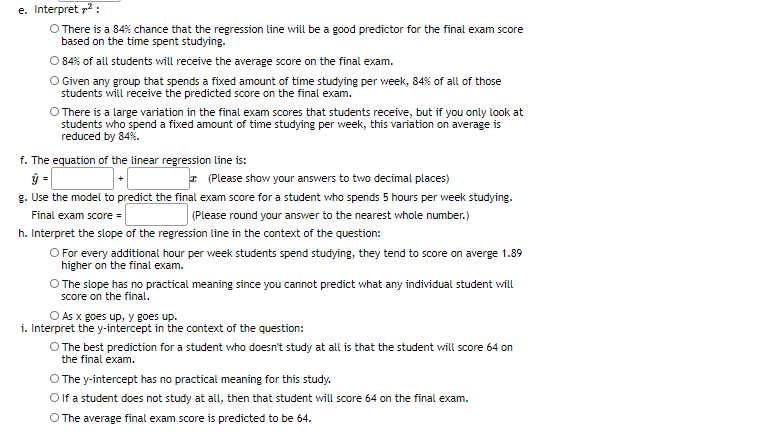What is the relationship between the amount of time statistics students study per week and their final exam scores? The results of the survey are shown below. 16 3 4 1 2 73 Time 15 10 3 Score 95 61 67 67 88 90 75 a. Find the correlation coefficient: 1 = Round to 2 decimal places. b. The null and alternative hypotheses for correlation are: H: ?v = o H: ?v + 0 The p-value is: (Round to four decimal places) c. Use a level of significance of a = 0.05 to state the conclusion of the hypothesis test in the context of the study. O There is statistically insignificant evidence to conclude that a student who spends more time studying will score higher on the final exam than a student who spends less time studying. O There is statistically significant evidence to conclude that there is a correlation between the time spent studying and the score on the final exam. Thus, the regression line is useful.
What is the relationship between the amount of time statistics students study per week and their final exam scores? The results of the survey are shown below. 16 3 4 1 2 73 Time 15 10 3 Score 95 61 67 67 88 90 75 a. Find the correlation coefficient: 1 = Round to 2 decimal places. b. The null and alternative hypotheses for correlation are: H: ?v = o H: ?v + 0 The p-value is: (Round to four decimal places) c. Use a level of significance of a = 0.05 to state the conclusion of the hypothesis test in the context of the study. O There is statistically insignificant evidence to conclude that a student who spends more time studying will score higher on the final exam than a student who spends less time studying. O There is statistically significant evidence to conclude that there is a correlation between the time spent studying and the score on the final exam. Thus, the regression line is useful.
Chapter4: Linear Functions
Section: Chapter Questions
Problem 30PT: For the following exercises, use Table 4 which shows the percent of unemployed persons 25 years or...
Related questions
Topic Video
Question

Transcribed Image Text:What is the relationship between the amount of time statistics students study per week and their final
exam scores? The results of the survey are shown below.
Time
Score
3
4
73
16
2
15
10
3
95
61
67
67
88
90
75
a. Find the correlation coefficient: r =
b. The null and alternative hypotheses for correlation are:
Hg: ?v = 0
H: ?v + 0
Round to 2 decimal places.
The p-value is:
(Round to four decimal places)
c. Use a level of significance of a = 0.05 to state the conclusion of the hypothesis test in the context
of the study.
O There is statistically insignificant evidence to conclude that a student who spends more time
studying will score higher on the final exam than a student who spends less time studying.
O There is statistically significant evidence to conclude that there is a correlation between the
time spent studying and the score on the final exam. Thus, the regression line is useful.
O There is statistically insignificant evidence to conclude that there is a correlation between the
time spent studying and the score on the final exam. Thus, the use of the regression line is not
appropriate.
O There is statistically significant evidence to conclude that a student who spends more time
studying will score higher on the final exam than a student who spends less time studying.
d. r2 =
(Round to two decimal places)

Transcribed Image Text:e. Interpret 72 :
O There is a 84% chance that the regression line will be a good predictor for the final exam score
based on the time spent studying.
O 84% of all students will receive the average score on the final exam.
O Given any group that spends a fixed amount of time studying per week, 84% of all of those
students will receive the predicted score on the final exam.
O There is a large variation in the final exam scores that students receive, but if you only look at
students who spend a fixed amount of time studying per week, this variation on average is
reduced by 84%.
f. The equation of the linear regression line is:
ŷ =
g. Use the model to predict the final exam score for a student who spends 5 hours per week studying.
I (Please show your answers to two decimal places)
| (Please round your answer to the nearest whole number.)
Final exam score =
h. Interpret the slope of the regression line in the context of the question:
O For every additional hour per week students spend studying, they tend to score on averge 1.89
higher on the final exam.
O The slope has no practical meaning since you cannot predict what any individual student will
score on the final.
O As x goes up, y goes up.
i. Interpret the y-intercept in the context of the question:
O The best prediction for a student who doesn't study at all is that the student will score 64 on
the final exam.
O The y-intercept has no practical meaning for this study.
O lf a student does not study at all, then that student will score 64 on the final exam.
O The average final exam score is predicted to be 64.
Expert Solution
This question has been solved!
Explore an expertly crafted, step-by-step solution for a thorough understanding of key concepts.
This is a popular solution!
Trending now
This is a popular solution!
Step by step
Solved in 2 steps with 1 images

Knowledge Booster
Learn more about
Need a deep-dive on the concept behind this application? Look no further. Learn more about this topic, statistics and related others by exploring similar questions and additional content below.Recommended textbooks for you


Glencoe Algebra 1, Student Edition, 9780079039897…
Algebra
ISBN:
9780079039897
Author:
Carter
Publisher:
McGraw Hill


Glencoe Algebra 1, Student Edition, 9780079039897…
Algebra
ISBN:
9780079039897
Author:
Carter
Publisher:
McGraw Hill